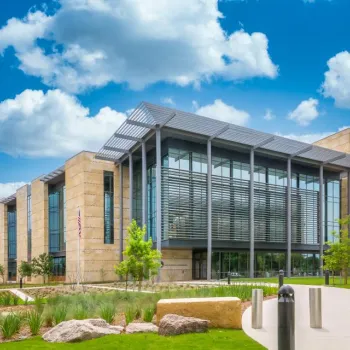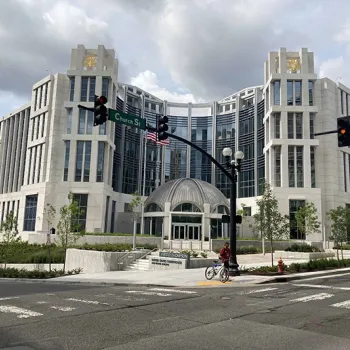Committed to efficiency, safety, and cost containment, the Judiciary responds in a coordinated way to emergencies while also working with the General Services Administration to replace outmoded courthouses with modern, secure facilities.
Judicial Security
In addition its work supporting the Daniel Anderl Judicial Security and Privacy Act, Judiciary leaders in 2022 focused on a high-priority initiative to upgrade, expand, and better fund security for federal judges and courthouses.
The proliferation of judges’ personally identifiable information (PII) on the internet has been a major concern for the Judiciary in the wake of several attacks on judges in recent years. In July 2020, a former litigant killed the son of New Jersey District Judge Esther Salas at the family’s home. Judge Salas’s husband was seriously wounded in the attack. The gunman acquired the judge’s address, photos of her home, and her vehicle information on the internet.
There also has been a dramatic rise in threats and inappropriate communications against federal judges and other court personnel, from 926 incidents in 2015 to 4,511 in 2021, according to the U.S. Marshals Service. Some cases have involved litigants angered by judges' decisions in cases. And the home addresses of judges handling controversial cases have been circulated on social media.
In 2022, the Administrative Office of the U.S. Courts (AO) began implementing the Vulnerability Management Program, an initiative endorsed the previous year by the Judicial Conference. Two new branches were added to the AO’s Judiciary Security Division: the Threat Management Branch and the Judiciary Security Operations Branch.
In March, the Threat Management Branch began assisting judges in removing or redacting their PII from online locations. More than 600 judges participated through November.
The new Threat Management Branch coordinates with other AO programs that assist judges in also removing their PII from LexisNexis and Westlaw records databases and from annual financial disclosure reports. The branch also promotes information-sharing between the Judiciary and the executive branch security providers and analyses threats against the Judiciary. It now has a branch chief and three security specialists.
Once fully implemented, the Judicial Security Operations Branch will coordinate the delivery of physical security and emergency preparedness programs for the Judiciary. A branch chief was hired in 2022, and the AO was working to hire 16 permanent circuit-level judiciary security officers. They will support courthouse security and preparedness programs for the courts and federal defender offices and coordinate communication between the Judiciary and executive-branch security and preparedness providers, such as the Marshals Service, the Federal Protective Service, and the General Services Administration (GSA).
Courthouse Security
Courthouse security took on heightened importance following outbreaks of civil unrest around the country and the Jan. 6 breach of the U.S. Capitol by election protestors. More than 50 courthouses across the country were damaged, and two security employees were shot near courthouses, one fatally.
The AO established an interagency group with representatives from the U.S. Marshals Service, the Federal Protective Service, and the GSA to begin work on an initiative to harden and protect courthouses.
Beginning in 2021 and throughout 2022, the group identified several measures to try to prevent unauthorized entry to courthouse buildings, including strengthening pedestrian-accessible windows and doors with break-resistant glass or coverings, installing magnetic automatic door locks that security officers can operate remotely, and installing temporary or permanent facility perimeter barriers or fencing.
The measures were given priority because they can be implemented relatively quickly and inexpensively while more significant, costlier measures are evaluated, such as redesigning and renovating entrances, perimeter spaces, and interior public spaces.
In fiscal year 2022, the Judiciary received $15 million from Congress for courthouse security. While every courthouse in the country would benefit from hardening, the fiscal year 2022 funding was targeted for facilities identified as highest risk. The Conference’s Judicial Security Committee approved criteria for setting priorities, including the amount of judicial activity within a facility, the extent of damage to courthouses or facilities during the civil unrest of recent years, threat information from federal law enforcement agencies, facility design and construction and hardening elements already incorporated, and the feasibility of cost-effective improvements to harden the perimeter.
In September 2022, Congress approved an additional $112.5 million in supplemental appropriations requested by the Judiciary to improve security at courthouses. The appropriation was part of the continuing resolution to keep the government operating until Dec. 16, 2022, allowing Congress additional time to complete work on the regular annual appropriations bills.
New Courthouse Construction
The AO is managing and supporting multiple projects that are part of a $1.4 billion commitment by Congress for courthouse construction around the country.
In recent years, the GSA purchased a courthouse in Rutland, VT; finished courthouse annexes in Charlotte, NC; and Savannah, GA; and completed courthouses in Nashville, TN; Greenville, SC; San Antonio, TX; and Anniston, AL. Still in progress are courthouse projects in Toledo, OH; Des Moines, IA; Harrisburg, PA; Huntsville, AL; Fort Lauderdale, FL; Greenville, MS; Chattanooga, TN; and Hartford, CT.
Also in progress is a plan for a federal facility in San Juan, Puerto Rico, which was prioritized as a judicial space emergency because of earthquake risks. A $262 million seismic retrofit is planned for the Federico Degetau Federal Building. The Degetau Federal Building and the Clemente Ruiz Nazario U.S. Courthouse compose the Hato Rey Federal Court Complex.
The federal courthouse construction program is administered jointly by the Judiciary and the GSA. The Judiciary establishes priorities for courthouse construction projects and sets the housing requirements for each project to ensure that completed facilities meet the needs of the courts. The GSA secures the funding for construction, acquires the building site, and completes design and construction work on the facilities. The Judiciary annually identifies potential locations for new courthouses, annexes, and major renovation of courthouses that have the most urgent space needs.
The GSA received approximately $1.4 billion from Congress in fiscal years 2016 and 2018 for courthouse construction projects identified as priorities by the Judiciary. In the most recent appropriations bill, for fiscal year 2023, the GSA received an additional $100 million for the courthouse projects in Hartford and Chattanooga. The bill also provided $55 million to address unavoidable cost increases at the Fort Lauderdale project.
Emergency Preparedness
During 2022, the AO assisted with emergency efforts in court districts affected by extreme weather, including recovery efforts in six court districts in the path of Hurricane Ian in late September. Throughout the year, staff monitored 121 severe weather incidents near court facilities and provided support to courts whose operations were disrupted or whose personnel were displaced. Weather-related disruptions were caused by wildfires, tropical storms, Hurricane Ian, and flooding. In each case, the AO facilitated coordination with affected court districts and partner agencies to restore operations, repair facilities, and relocate operations as necessary. AO staff also worked with courts on COVID-19 reopening measures and on their emergency preparedness plans, which covered topics such as business and operations continuity.
Annual Report 2022
- Annual Report 2022
- Funding and Budget
- The Courts and Congress
- The Federal Bench
- Accountability and Resource Management
- Public Outreach and Communications
- Facilities and Security
- Court Operations
- Defender Services
- Probation and Pretrial Services
- Human Resources
- Information Systems and Cybersecurity
- Recent and Proposed Amendments to Federal Rules
- In Profile




